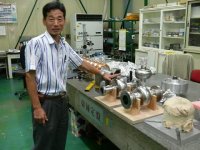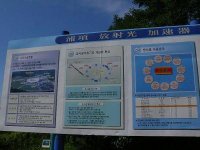|
“Daegu is exactly a one-hour drive away from Pohang. So I visit Daegu frequently, and vice versa, because people from Kyongpook National University come to Pohang,” said Won Namkung, professor at Pohang University of Science and Technology (POSTECH) and Asian Linear Collider Steering Committee chair. These two cities, Daegu and Pohang, are the centres for Korean ILC R&D. Ever since one of the centres, the Pohang Accelerator Laboratory (PAL), a synchrotron light source facility in Korea, organised an ILC Task Force Team in 2004, the members have been working in various fields of study and have already achieved some milestones.

Young Uk Sohn explains about Korea's superconducting cavity programme. |

The view of the Pohang Light Source. |

Posters at Pohang Accelerator Laboratory. |
PAL researchers are concentrating on superconducting cavities and related technologies. “We did not have any experience with superconducting cavities before we organised the Task Force. The Korean R&D programme only required normal-conducting technology, but we needed to get ready for a future Korean programme, which definitely will require superconducting technology,” said Young Uk Sohn, senior researcher at Basic Engineering Department of PAL.
Now Korea is at a stage where it can start small-scale industrialisation for superconducting cavities. “The first stage was for training our engineers, developing single-cell cavities to install in our storage ring. The second stage was to fabricate a nine-cell cavity, welded by a Japanese company. For the development of both cavities, Kenji Saito's team at KEK advised us and we used KEK facilities. Now, at the third stage of R&D, we started to study by ourselves with our own facilities,” said Sohn. They will finish fabricating their second nine-cell cavity including integration welding in Korea, which will be sent to KEK for vertical testing in September.
This is the first real superconducting radiofrequency (SCRF) nine-cell cavity manufactured in Korea. They have prepared SCRF test facilities for R&D at PAL that will be done in 2007 for single-cell cavities and in 2009 for nine-cells. “The low-loss cavity is an alternative design for ILC, but we find it meaningful to participate in the challenging Asian programme,” said Jin Hyuk Choi, Accelerator Division Head at PAL. “It is very convenient for us too, because KEK is so close to us,” Choi added. The first cavity, which was fabricated last March, will be installed into the Superconducting Test Facility Phase 1 at KEK later this year.
“We have produced 44 cavity beam position monitors since 2005, and we actually achieved their goal performance for the KEK ATF2 and PAL XFEL,” said Jung Yun Huang, scientist at the Accelerator division at PAL. Two beam position monitors have been installed in their facility. From the experience in the cavity beam position monitor production, they have established an engineering procedure and acquired the fabrication techniques. “We have two goals for the cavity beam position monitor programme. One is to provide 41 beam position monitors for the ATF2 project at KEK, and the other is for Korean XFEL application,” said Huang. The required resolution of beam position monitor for ATF2, a test facility for the final focus system that is envisaged for the ILC, is 200 nanometres per single path measurement, which PAL has achieved with a better result of 100 nanometres. The construction of components for ATF2 started in 2005, and an initial beam operation is expected in 2008.
They are seeking closer collaboration with another Asian laboratory, IHEP in China, regarding R&D for damping rings. “We don't have all the facilities we need for our R&D effort here, but it is less than a one hour flight to Beijing, and only two hours to Japan. It is very convenient for us to have a close relationship within Asia,” says Jin Hyuk Choi. This is a time when the communication is possible anywhere, anytime. Still, the geographical closeness helps Korea boost their ILC R&D programme.
-- Rika Takahashi
|




